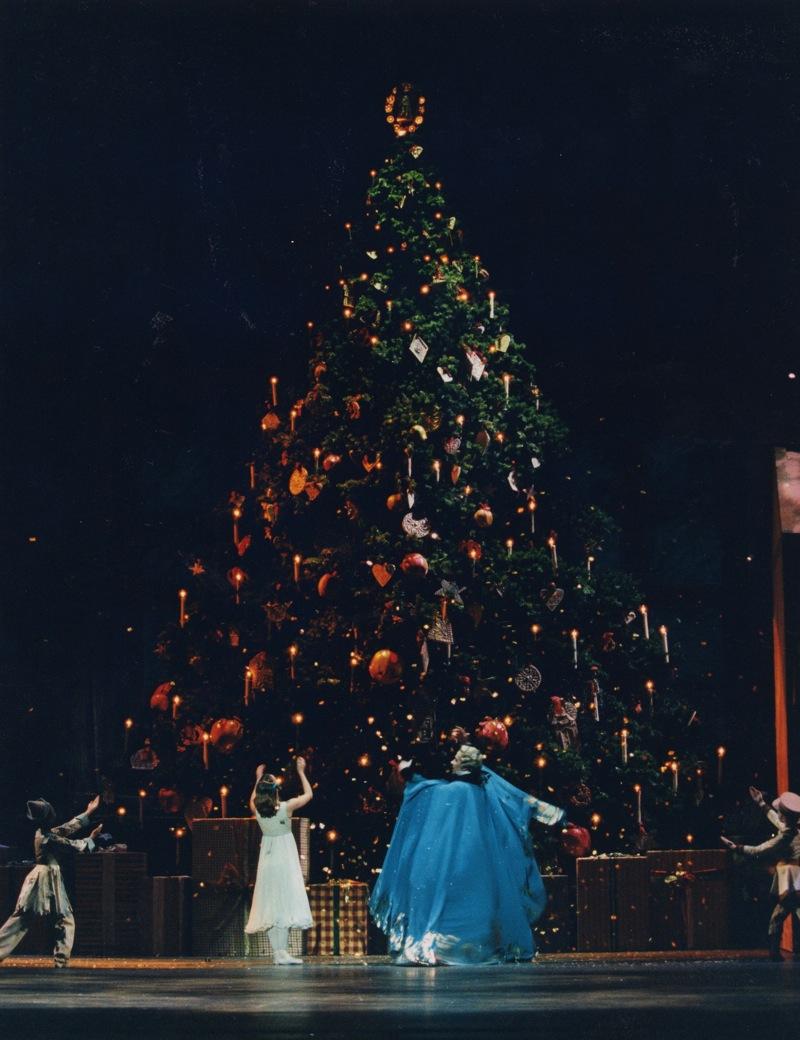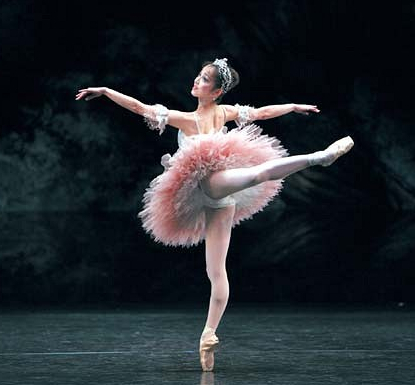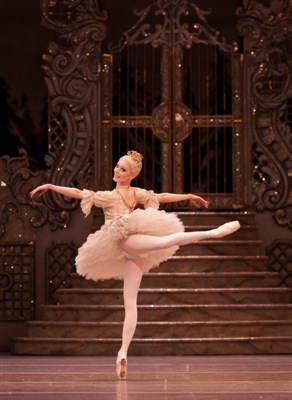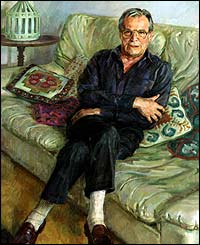In the realm of the Nutcracker king | reviews, news & interviews
In the realm of the Nutcracker king
In the realm of the Nutcracker king
ARCHIVE Daily Telegraph, 18 December 2000: Sir Peter Wright talks to Ismene Brown about his two productions of Tchaikovsky’s best-loved ballet

At this time of year people who love ballet divide into two tribes: those who are too sophisticated for The Nutcracker and those who will never been too sophisticated for The Nutcracker. The former will say that The Nutcracker is a children’s ballet. For the latter, Christmas would not be Christmas without hearing probably the most familiar and adored of Tchaikovsky’s music scores.
One man has the means to both persuade the doubters and satiate the faithful - Sir Peter Wright, the creator of two great productions of The Nutcracker that this Christmas will be vying to brand the ballet’s magical mystery trip on the public’s imagination. The Royal Ballet and Birmingham Royal Ballet each have a Wright Nutcracker, and different as they are I think it would be difficult to emerge from either of them still believing that The Nutcracker is some overblown piece of artistic tinsel.
The Royal’s is a magnificent Germanic version that looks dipped in spun sugar, and tells us about a grieving old man’s search to find a lost boy. Birmingham’s is a luscious Victoria-English one full of deceiving stage wizardry, and tells us about a young girl’s dream of growing up and discovering love. How can such different tales emerge from one ballet? Because, paradoxically, of the early failure of The Nutcracker in St Petersburg on its premiere on 6 December 1892.
“Out of the five classics - Swan Lake, Sleeping Beauty, Giselle, Nutcracker and Coppelia - Nutcracker is the only one which never had a satisfactory story. The original scenario was constructed like two separate ballets, almost, with hardly any link,” explains Sir Peter. A fit-looking, handsome 74, he is one of dance’s most distinguished people, former director of Birmingham Royal Ballet and, some think, the best director the Royal Ballet never had
 He is also acknowledged worldwide as a master of staging classical ballet productions. He has done two dozen, known for dramatic freshness while keeping all the classical dignity of the dance. His two Nutcrackers, for the Royal Ballet in 1984 and Birmingham Royal in 1990, both set right the flaws of the first performance. (Pictured, Birmingham's Nao Sakuma as the Sugar Plum Fairy, photo Steve Hanson)
He is also acknowledged worldwide as a master of staging classical ballet productions. He has done two dozen, known for dramatic freshness while keeping all the classical dignity of the dance. His two Nutcrackers, for the Royal Ballet in 1984 and Birmingham Royal in 1990, both set right the flaws of the first performance. (Pictured, Birmingham's Nao Sakuma as the Sugar Plum Fairy, photo Steve Hanson)
Although it’s hard to imagine when one hears the scintillating, shimmering music of The Nutcracker, Tchaikovsky had a miserable time composing it. Fresh from the tremendous stimulation of The Sleeping Beauty, he now had a scenario that inspired not at all - broken in half. In the first act Clara was given a Nutcracker doll, whom she helped to win a great battle with King Rat - and who then turned into a prince. In the second, Clara was shown the Kingdom of Sweets as a reward, and a splendid pageant of dance climaxing in the Sugar Plum Fairy. In fact, as the Tchaikovsky expert Roland John Wiley pithily summed up, “The leading characters do virtually no dancing, and the leading dancers have virtually no place in the story.” (Pictured right, the Royal's Sarah Lamb as the Sugar Plum Fairy, photo Bill Cooper)
 Apart from the plot’s defects, most of the original choreography by Lev Ivanov (creator of Swan Lake’s “white” swan acts 2 and 4) was also lost before long, rewritten by others, apart from the final grand pas de deux and notes on the Snowflakes scene ending Act 1. What kept it from oblivion was the music, of course, but also its theme of Christmas and the supernatural. This took hold of producers’ imaginations, particularly in Britain, where Nutcracker is considered as seasonal as plum pudding and turkey. (In Russia, oddly enough, Nutcracker was a year-round attraction.)
Apart from the plot’s defects, most of the original choreography by Lev Ivanov (creator of Swan Lake’s “white” swan acts 2 and 4) was also lost before long, rewritten by others, apart from the final grand pas de deux and notes on the Snowflakes scene ending Act 1. What kept it from oblivion was the music, of course, but also its theme of Christmas and the supernatural. This took hold of producers’ imaginations, particularly in Britain, where Nutcracker is considered as seasonal as plum pudding and turkey. (In Russia, oddly enough, Nutcracker was a year-round attraction.)
Many people have seized this elusive, fragile concoction of music and spectacle and tried to shake some meaning into it. They have leapt upon the original story, Nutcracker and Mouse King, by the strange German storywriter E T A Hoffmann. They have gone for Freudian psychology, or childish sweeties overload - or, in two irreverent modern versions by Matthew Bourne and Mark Morris, sex. The finest choreographic version is Balanchine’s for New York City Ballet, but one wonders what might have been had the Royal Ballet’s presiding genius Frederick Ashton expanded his beauteous1951 shorthand version Casse-Noisette into the full article.
Is Clara 10 and interested in toys, or 16 and interested in boys? These crucial decisions make for very different demands
The main question, though, is whether to centre the ballet on Clara or the mysterious Dr Drosselmeyer. Should Clara dream up the delights or should the magician? Is Clara 10 and interested in toys, or 16 and interested in boys? These crucial decisions make for very different demands in choreography, storytelling and visual design.
When preparing the Covent Garden production for the Royal Ballet, Wright was decisively influenced by Hoffmann’s delineation of Drosselmeyer, whose nephew has been turned into the Nutcracker doll by King Rat’s evil magic. “Drosselmeyer’s a lonesome man carrying around this terrible sadness. In the original story he is old and unattractive, and has a patch on his eye - children are frightened of him. It saddens me.”
Wright makes us care about Dr Drosselmeyer from the first. He goes to young Clara’s Christmas party determined that she is the girl to break the spell on his nephew. When she does, he gratefully sends her and the lad to the fantastical Sugar Garden, on a prize blind date.
When reviving the London production this time round, Wright made a deft tweak to the ending, true to the spirit if not the letter of Hoffmann. He ends the ballet in the real world - Clara catches the eye of a boy outside her house who looks strangely like the nephew in her fantasy... It is one of several enlivening updates in a production that had got a bit staid 16 years after its creation. In 1984 Wright had aimed originally at fidelity to both Hoffmann and Ivanov, using the surviving remnants of notated choreography as the basis for his beautiful Snowflakes scene. The designs by Julia Trevelyan Oman are, rightly, solidly majestic for Clara’s home in Act 1, and glitter with icing sharpness in Act 2’s Sugar Garden.
 However, the Birmingham experience had shown him what needed tightening up in London. “I wanted to keep the interest of children - I’ve always felt that Act 2 can be pretty hard going for them, because they tire easily when just watching dancing,” says Sir Peter engagly. “In the past when children came to this production I’ve known them to tell me, ‘A bit long, the second half.’ This time three of my five grandchildren have seen it and they absolutely adored the second act as much as the first.” (Pictured right, June Mendoza's portrait of Sir Peter Wright)
However, the Birmingham experience had shown him what needed tightening up in London. “I wanted to keep the interest of children - I’ve always felt that Act 2 can be pretty hard going for them, because they tire easily when just watching dancing,” says Sir Peter engagly. “In the past when children came to this production I’ve known them to tell me, ‘A bit long, the second half.’ This time three of my five grandchildren have seen it and they absolutely adored the second act as much as the first.” (Pictured right, June Mendoza's portrait of Sir Peter Wright)
The London version is now a denser, more reflective reading than the Birmingham production. Yet for magic, as well as for sheer dramatic fluency, the Midlands one is superior. BRB’s Drosselmeyer does impressive conjuring tricks, and nowhere else in the world can there be a more wizard transformation scene, when the Christmas tree in Clara’s house begins to grow and the entire theatre seems to shrink. It is a coup de théâtre that you will never forget.
The stage fills up with branches and candles, and then it climaxes when the whole wall turns round with the huge fireplace in it. It is just brilliant
“What my designer John Macfarlane did for Birmingham is the most wonderful thing,” says Sir Peter. “I mean, I love the tree at Covent Garden, but the story does say that the branches almost come in through the doors and windows, and it’s what John succeeded in doing, with the most immensely careful timing. The stage fills up with branches and candles, and then it climaxes when the whole wall turns round with the huge fireplace in it. It is just brilliant.”
Wright created the Birmingham production during his 18-year directorship of the company, to celebrate BRB’s move from London in 1990. It has a younger, more freely romantic quality than the earlier, and he feels it has a better impetus too.
“The accent is more on Clara’s awakening to love, you might say. I’ve got no deep psychological thoughts about it - I just wanted to make a simple, clear story about a young girl who’s affected by what happens at her party, and the magic that’s afoot. It’s her dream, not Drosselmeyer’s fantasy - unlike London.”
So - a child’s dream of sweets, or a teenager’s of love, or a lonely old man’s of seeing his nephew again. Take your pick. It hardly makes sense, but The Nutcracker’s elusiveness is no barrier to its undying popular appeal. What is its magic?
“You’ve got the right word there, ‘magic’,” Wright agrees. “It’s not magic tricks, it’s the magic of the music, the magic of the fantasy, the magic of dance. Everything is touched by this glorious, wonderful score. Some of the music in Nutcracker is simply the best there is. It’s those moments that one thinks, ‘My goodness, if people don’t believe that there’s some great wondrous creative force to be called God, here’s the evident.’ What else could make someone write such music?”
Share this article
The future of Arts Journalism
You can stop theartsdesk.com closing!
We urgently need financing to survive. Our fundraising drive has thus far raised £49,000 but we need to reach £100,000 or we will be forced to close. Please contribute here: https://gofund.me/c3f6033d
And if you can forward this information to anyone who might assist, we’d be grateful.

Subscribe to theartsdesk.com
Thank you for continuing to read our work on theartsdesk.com. For unlimited access to every article in its entirety, including our archive of more than 15,000 pieces, we're asking for £5 per month or £40 per year. We feel it's a very good deal, and hope you do too.
To take a subscription now simply click here.
And if you're looking for that extra gift for a friend or family member, why not treat them to a theartsdesk.com gift subscription?
more Dance
 'We are bowled over!' Thank you for your messages of love and support
Much-appreciated words of commendation from readers and the cultural community
'We are bowled over!' Thank you for your messages of love and support
Much-appreciated words of commendation from readers and the cultural community
 R:Evolution, English National Ballet, Sadler's Wells review - a vibrant survey of ballet in four acts
ENB set the bar high with this mixed bill, but they meet its challenges thrillingly
R:Evolution, English National Ballet, Sadler's Wells review - a vibrant survey of ballet in four acts
ENB set the bar high with this mixed bill, but they meet its challenges thrillingly
 Like Water for Chocolate, Royal Ballet review - splendid dancing and sets, but there's too much plot
Christopher Wheeldon's version looks great but is too muddling to connect with fully
Like Water for Chocolate, Royal Ballet review - splendid dancing and sets, but there's too much plot
Christopher Wheeldon's version looks great but is too muddling to connect with fully
 iD-Reloaded, Cirque Éloize, Marlowe Theatre, Canterbury review - attitude, energy and invention
A riotous blend of urban dance music, hip hop and contemporary circus
iD-Reloaded, Cirque Éloize, Marlowe Theatre, Canterbury review - attitude, energy and invention
A riotous blend of urban dance music, hip hop and contemporary circus
 How to be a Dancer in 72,000 Easy Lessons, Teaċ Daṁsa review - a riveting account of a life in dance
Michael Keegan-Dolan's unique hybrid of physical theatre and comic monologue
How to be a Dancer in 72,000 Easy Lessons, Teaċ Daṁsa review - a riveting account of a life in dance
Michael Keegan-Dolan's unique hybrid of physical theatre and comic monologue
 A Single Man, Linbury Theatre review - an anatomy of melancholy, with breaks in the clouds
Ed Watson and Jonathan Goddard are extraordinary in Jonathan Watkins' dance theatre adaptation of Isherwood's novel
A Single Man, Linbury Theatre review - an anatomy of melancholy, with breaks in the clouds
Ed Watson and Jonathan Goddard are extraordinary in Jonathan Watkins' dance theatre adaptation of Isherwood's novel
 Peaky Blinders: The Redemption of Thomas Shelby, Rambert, Sadler's Wells review - exciting dancing, if you can see it
Six TV series reduced to 100 minutes' dance time doesn't quite compute
Peaky Blinders: The Redemption of Thomas Shelby, Rambert, Sadler's Wells review - exciting dancing, if you can see it
Six TV series reduced to 100 minutes' dance time doesn't quite compute
 Giselle, National Ballet of Japan review - return of a classic, refreshed and impeccably danced
First visit by Miyako Yoshida's company leaves you wanting more
Giselle, National Ballet of Japan review - return of a classic, refreshed and impeccably danced
First visit by Miyako Yoshida's company leaves you wanting more
 Quadrophenia, Sadler's Wells review - missed opportunity to give new stage life to a Who classic
The brilliant cast need a tighter score and a stronger narrative
Quadrophenia, Sadler's Wells review - missed opportunity to give new stage life to a Who classic
The brilliant cast need a tighter score and a stronger narrative
 The Midnight Bell, Sadler's Wells review - a first reprise for one of Matthew Bourne's most compelling shows to date
The after-hours lives of the sad and lonely are drawn with compassion, originality and skill
The Midnight Bell, Sadler's Wells review - a first reprise for one of Matthew Bourne's most compelling shows to date
The after-hours lives of the sad and lonely are drawn with compassion, originality and skill
 Ballet to Broadway: Wheeldon Works, Royal Ballet review - the impressive range and reach of Christopher Wheeldon's craft
The title says it: as dancemaker, as creative magnet, the man clearly works his socks off
Ballet to Broadway: Wheeldon Works, Royal Ballet review - the impressive range and reach of Christopher Wheeldon's craft
The title says it: as dancemaker, as creative magnet, the man clearly works his socks off
 The Forsythe Programme, English National Ballet review - brains, beauty and bravura
Once again the veteran choreographer and maverick William Forsythe raises ENB's game
The Forsythe Programme, English National Ballet review - brains, beauty and bravura
Once again the veteran choreographer and maverick William Forsythe raises ENB's game

Add comment